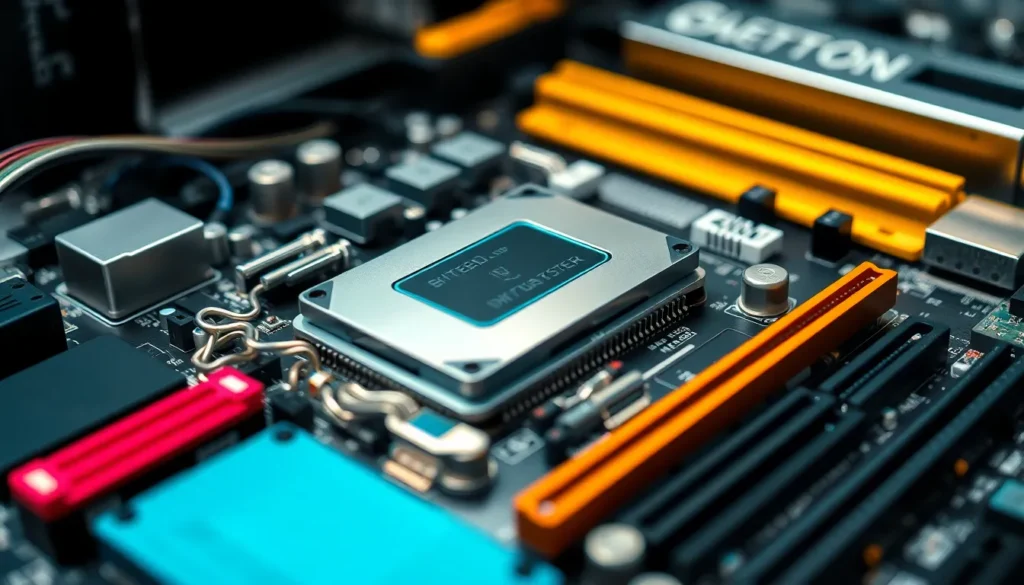Imagine trying to bake a cake without an oven or mixing bowl. Sounds messy, right? That’s exactly what it’s like to use a computer without hardware. Hardware is the physical backbone of any tech device, from your trusty laptop to the smartphone glued to your hand. It’s the tangible stuff that makes all the digital magic happen, and without it, your favorite apps would just be a bunch of pixels floating in cyberspace.
What Is Hardware?
Hardware encompasses all the physical components of a computer or electronic device. This includes elements like the central processing unit (CPU), memory (RAM), storage devices, and peripherals. Each component works in unison to facilitate operations, enabling users to run applications and manage tasks effectively.
Processors act as the brain of the device, executing instructions and performing calculations. Memory serves as short-term storage to store data needed for immediate tasks. Storage devices retain information long-term, encompassing hard drives, solid-state drives, and external drives.
Peripherals such as keyboards, mice, and printers enhance user interaction. They connect to the main system, allowing input and output of data. Network interface cards and motherboards provide essential communication pathways between components, ensuring efficient data transfer.
Various types of hardware cater to different needs and applications. Custom-built systems deliver specific functionalities for gaming or graphic design. Embedded systems control devices like microwaves, while mobile devices integrate compact hardware for portability.
The evolution of hardware continuously influences technology. Improved performance capabilities, reduced energy consumption, and enhanced miniaturization offer users better experiences. Emerging technologies, like quantum computing hardware, redefine possibilities for future applications.
Understanding hardware’s role enhances comprehension of technology. It highlights the relationship between physical components and their functionalities within the digital ecosystem. Each hardware type contributes uniquely, creating the infrastructure necessary for software to operate fully.
Categories of Hardware

Hardware consists of various categories that fulfill different roles within computer systems and electronic devices.
Input Devices
Input devices allow users to interact with computers and send data. Key examples include keyboards, mice, and scanners. Keyboards facilitate data entry through alphanumeric characters. Mice offer point-and-click navigation, enabling users to select and manipulate objects on-screen. Scanners convert physical documents into digital formats, granting digital accessibility. Touchscreens allow direct user interaction through tactile gestures. Voice recognition systems enable commands through spoken words. Cameras capture images for video calls or photographs, enhancing communication. Each input device contributes uniquely to the overall user experience.
Output Devices
Output devices deliver information from computers to users in various formats. Common examples encompass monitors, printers, and speakers. Monitors produce visual displays, rendering text and images for user interpretation. Printers generate physical copies of digital documents, facilitating the sharing of information in tangible form. Speakers emit sound, providing audio output for music, alerts, or communication. Projectors create large visual displays for presentations and events, serving larger audiences. Headphones allow personal audio consumption, enhancing user experience without disturbing others. Each output device plays a crucial role in communicating processed information.
Storage Devices
Storage devices retain and manage digital data for long-term access. Hard drives represent a primary example, offering significant capacity for files and applications. Solid-state drives provide faster data access speeds, improving performance in devices. Flash drives serve as portable storage solutions, allowing easy file transfer between systems. Optical discs, such as CDs and DVDs, store music, videos, and software. Network-attached storage devices provide shared access to data across multiple systems, enhancing collaboration. Cloud storage solutions offer remote data access via the internet, ensuring data availability anytime, anywhere. Each storage device serves distinct needs in data management and retrieval.
The Role of Hardware in Computing
Hardware serves as the backbone of computing, directly impacting functionality and performance. Understanding this relationship enriches insights into how devices operate.
Interaction with Software
Interaction with software occurs through various hardware components. Input devices like keyboards and mice allow users to communicate commands to software applications. Simultaneously, output devices such as monitors and printers present information, completing the interaction loop. This collaboration between hardware and software ensures that users can execute tasks efficiently. Each component plays its part, facilitating a seamless user experience across diverse applications.
Performance and Optimization
Performance and optimization hinge on the quality of hardware. A powerful CPU accelerates processing speeds, allowing applications to run smoothly. Ample RAM enhances multitasking capabilities, enabling users to switch between numerous programs without interruption. Storage devices significantly influence data retrieval times, impacting overall efficiency. By integrating advanced hardware solutions, such as solid-state drives and high-quality graphics cards, systems become better equipped to handle demanding tasks. Understanding these dynamics aids users in selecting appropriate hardware, maximizing system potential.
Evolution of Hardware
The evolution of hardware has transformed computing since its inception. Early computers used vacuum tubes and relay switches, which were bulky and inefficient. Transistors later replaced these components, marking a significant leap in size reduction and energy efficiency. The introduction of integrated circuits further revolutionized hardware, allowing for greater complexity in smaller packages.
Personal computers emerged in the late 20th century, making technology accessible to the average user. Innovations continued with the development of microprocessors, which combined multiple functions into single chips. This advancement facilitated the rise of laptops and portable devices, changing how individuals interacted with technology.
As hardware progressed, so did storage solutions. Traditional hard drives evolved into solid-state drives, offering faster data retrieval and improved reliability. Graphics processing units (GPUs) became essential for enhancing visual performance, particularly in gaming and graphic design.
Recent developments include quantum computing hardware and advanced robotics. These technologies may redefine computational limits, pushing boundaries further than ever thought possible. Additionally, energy efficiency remains a focal point for hardware evolution, as manufacturers strive to reduce environmental impact while enhancing performance.
Hardware evolution continually shapes user experience, influencing choices for personal and professional use. Each advancement introduces new capabilities, making tasks easier and more efficient. Understanding this progression illuminates the intricate relationship between hardware components and their contributions to the digital environment.
Conclusion
Hardware serves as the backbone of all technological devices enabling users to interact with software and access digital content. Its various components work in harmony to deliver performance and efficiency. As technology continues to evolve hardware adapts and transforms paving the way for innovations that enhance user experience. Understanding the significance of hardware not only helps individuals make informed choices but also deepens their appreciation for the intricate systems that power today’s digital world. Embracing the latest advancements ensures users stay ahead in an ever-changing technological landscape.


More Stories
Bundling with PC Components: The Secret to Easier Builds and Big Savings
PC Hardware Upgrade Scanner: Discover Your System’s Perfect Upgrade Path Today
PC Hardware Little Rock: Uncover the Best Components for Gamers and Creators